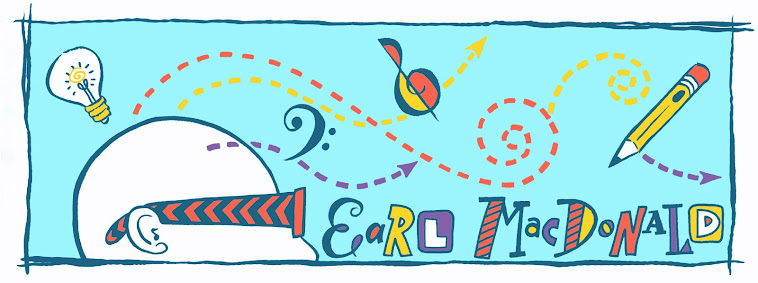On occasion I like to dabble in the world of free jazz. Trumpeter John Allmark has been quoted as saying "they call it free jazz because no one will pay to hear it." Although I agree that free jazz is not the most accessible, easy-listening music, I definitely see merits to playing free --- both within jazz education and for my own personal artistic growth and expression.
When discussing free jazz, I like to ask the question, "Free of what?" The improviser can be liberated and encouraged to experiment outside of the usual parameters by subtracting one or more of the following musical elements: predetermined form, tonality, key signature, standard notation, set rhythms, melodies, harmonies, tempo, time signature, etc.
This tune, "Looking Forward, Looking Back", does have a roadmap and form (including a Dal segno and Coda), but is otherwise notated using an unconventional graphic format. Using contrasting, cued events, a story unfolds.
Here is the score, so you can follow along: (Click on the image to enlarge it.)
I refer to this type of composition as "guided free improvisation". In my recent recording session with the Creative Opportunity Workshop (COW), we recorded four pieces incorporating this compositional technique.
I have successfully used some of these pieces in educational settings, when working with beginner improvisers. Graphic scores provide "an in" (starting point) for those who don't yet know their chords, scales and the dauntingly vast amounts of theory required to outline harmonic progressions. Obviously I teach this material too, but I like getting them playing ASAP, and overwhelming them isn't always productive. Paralysis by Analysis --- as Bill Fielder used to call it.
Imagine the creative explosion/renaissance that might occur if every kid's first musical assignment was to make a list of 12 extended instrumental techniques to demonstrate at their next lesson.
When discussing free jazz, I like to ask the question, "Free of what?" The improviser can be liberated and encouraged to experiment outside of the usual parameters by subtracting one or more of the following musical elements: predetermined form, tonality, key signature, standard notation, set rhythms, melodies, harmonies, tempo, time signature, etc.
This tune, "Looking Forward, Looking Back", does have a roadmap and form (including a Dal segno and Coda), but is otherwise notated using an unconventional graphic format. Using contrasting, cued events, a story unfolds.
Here is the score, so you can follow along: (Click on the image to enlarge it.)
I refer to this type of composition as "guided free improvisation". In my recent recording session with the Creative Opportunity Workshop (COW), we recorded four pieces incorporating this compositional technique.
I have successfully used some of these pieces in educational settings, when working with beginner improvisers. Graphic scores provide "an in" (starting point) for those who don't yet know their chords, scales and the dauntingly vast amounts of theory required to outline harmonic progressions. Obviously I teach this material too, but I like getting them playing ASAP, and overwhelming them isn't always productive. Paralysis by Analysis --- as Bill Fielder used to call it.
Imagine the creative explosion/renaissance that might occur if every kid's first musical assignment was to make a list of 12 extended instrumental techniques to demonstrate at their next lesson.


No comments:
Post a Comment